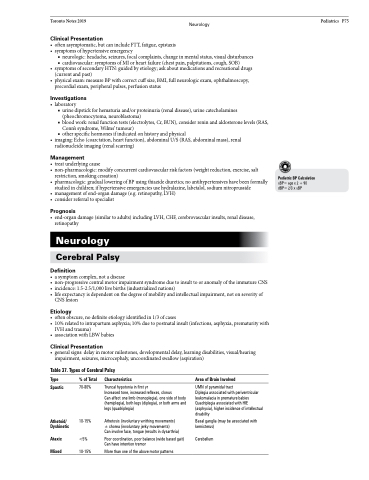Page 1109 - TNFlipTest
P. 1109
Toronto Notes 2019 Neurology
Clinical Presentation
• oftenasymptomatic,butcanincludeFTT,fatigue,epistaxis
• symptomsofhypertensiveemergency
■ neurologic: headache, seizures, focal complaints, change in mental status, visual disturbances
■ cardiovascular: symptoms of MI or heart failure (chest pain, palpitations, cough, SOB)
• symptomsofsecondaryHTN:guidedbyetiology;askaboutmedicationsandrecreationaldrugs
(current and past)
• physicalexam:measureBPwithcorrectcuffsize,BMI,fullneurologicexam,ophthalmoscopy,
precordial exam, peripheral pulses, perfusion status
Investigations
• laboratory
■ urine dipstick for hematuria and/or proteinuria (renal disease), urine catecholamines
(pheochromocytoma, neuroblastoma)
■ blood work: renal function tests (electrolytes, Cr, BUN), consider renin and aldosterone levels (RAS,
Conn’s syndrome, Wilms’ tumour)
■ other specific hormones if indicated on history and physical
• imaging:Echo(coarctation,heartfunction),abdominalU/S(RAS,abdominalmass),renal radionucleide imaging (renal scarring)
Management
• treatunderlyingcause
• non-pharmacologic:modifyconcurrentcardiovascularriskfactors(weightreduction,exercise,salt
restriction, smoking cessation)
• pharmacologic:gradualloweringofBPusingthiazidediuretics;noantihypertensiveshavebeenformally
studied in children; if hypertensive emergencies use hydralazine, labetalol, sodium nitroprusside
• managementofend-organdamage(e.g.retinopathy,LVH)
• considerreferraltospecialist
Prognosis
• end-organdamage(similartoadults)includingLVH,CHF,cerebrovascularinsults,renaldisease, retinopathy
Neurology
Cerebral Palsy
Definition
• asymptomcomplex,notadisease
• non-progressivecentralmotorimpairmentsyndromeduetoinsulttooranomalyoftheimmatureCNS • incidence:1.5-2.5/1,000livebirths(industrializednations)
• lifeexpectancyisdependentonthedegreeofmobilityandintellectualimpairment,notonseverityof
CNS lesion
Etiology
• oftenobscure,nodefiniteetiologyidentifiedin1/3ofcases
• 10%relatedtointrapartumasphyxia;10%duetopostnatalinsult(infections,asphyxia,prematuritywith
IVH and trauma)
• associationwithLBWbabies
Clinical Presentation
• generalsigns:delayinmotormilestones,developmentaldelay,learningdisabilities,visual/hearing impairment, seizures, microcephaly, uncoordinated swallow (aspiration)
Pediatrics P75
Pediatric BP Calculation
sBP=agex2+90 dBP= 2/3 x sBP
Table 37. Types of Cerebral Palsy
Type
Spastic
Athetoid/ Dyskinetic
Ataxic Mixed
% of Total
70-80%
10-15%
<5% 10-15%
Characteristics
Truncal hypotonia in first yr
Increased tone, increased reflexes, clonus
Can affect one limb (monoplegia), one side of body (hemiplegia), both legs (diplegia), or both arms and legs (quadriplegia)
Athetosis (involuntary writhing movements) ± chorea (involuntary jerky movements)
Can involve face, tongue (results in dysarthria)
Poor coordination, poor balance (wide based gait) Can have intention tremor
More than one of the above motor patterns
Area of Brain Involved
UMN of pyramidal tract
Diplegia associated with periventricular leukomalacia in premature babies Quadriplegia associated with HIE (asphyxia), higher incidence of intellectual disability
Basal ganglia (may be associated with kernicterus)
Cerebellum


